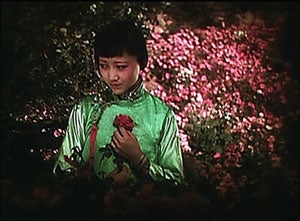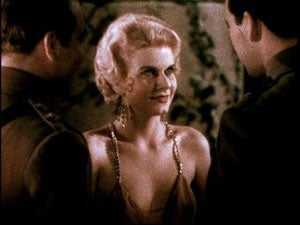
Photo: Robert Gitt (right) at his first day at the Archive on July 1, 1977.
Robert Gitt graduated from Dartmouth College in 1963 and began working at the American Film Institute in Washington D.C. in 1970. In 1977 he became Preservation Officer at UCLA Film & Television Archive, where he has personally preserved or supervised the preservation of more than 360 feature films, as well as hundreds of short subjects. We interviewed Gitt in 2006, when the Archive presented a tribute evening at the James Bridges Theater in honor of his many years of outstanding service and unparalleled achievement in the field of film preservation.
How did you get started in film preservation?
After college I continued to work for Dartmouth in the film department, and I helped to program the film society at the arts center there. I did the projection, and I did the posters, and I did the programming. I also began collecting films on my own, both 16mm used prints and 35mm used prints. During that period in the '60s I amassed a nice film collection. This was before the days of DVDs and videotapes and it was very hard to see films. I had some wonderful Hitchcock titles and Orson Welles films. I collected classic movies, from the silent era through the '50s.
This in a sense is how I ultimately got into film preservation and restoration, because what would happen is you would get a print of a movie and it would be very beat up. It had been through the mill. It had a reel missing, or it had some scenes missing, or part of it was scratched badly or full of splices. So sometimes what I would do was find more than one print and I would then put them together and make one full-length, complete print by intercutting back and forth and mixing and matching and making a good print. That's how I started doing film restoration.

What do you consider to be the goal of film preservation?
I guess the goal of film preservation is to make new copies of the film available to present-day audiences that look and sound just as good as the film did when it was new. Also to bring the film back to its original length, if the film has been censored through the years or if the studio has interfered. In some cases you want people to see the director's original cut. I do think it's important to preserve various versions of the film—the director's cut, but also the way the film was released, and maybe the way it was censored too. Even perhaps the way it was shown on television. Ultimately, if you can find the funds, I think it's good to preserve all those various forms so that people can study how films were handled.
What is the difference between preservation and restoration?
There are a number of things that are involved. You have conservation, which is basically gathering negatives, prints of new films, old films, short subjects, feature films, silent films, whatever, and storing them carefully under proper temperature and humidity conditions. Inspecting them, cleaning them, caring for them. Making repairs and so on. That's conservation.
In a sense that blends into preservation. Preservation to a certain degree means transferring films that are in an unstable form—a nitrate base or an early acetate base, which we now know deteriorates or disintegrates in its own way—and transferring this material to a more stable medium which we hope will last for hundreds of years into the future.

That brings us to restoration, which could imply simply doing a superior job of preservation, of getting the picture as sharp and clear, of getting the colors and the sound as good as possible. It could mean leaving the sound and picture alone in terms of not enhancing them unduly but simply removing wear and tear, removing artifacts of age: noisy scratches on the soundtrack, or scratches and dirt particles on the image. It also implies putting scenes back into a film that were censored or missing, as we've done with many films here at UCLA.
How has the field of film preservation changed over the years?
The early part of my career was very much hands-on. Literally. You used to go into the film vaults and open up rusty old cans. It was wonderful just to rummage around in an old film vault. You never knew what you were going to find. I found a lot of interesting old silent short subjects and cartoons just looking around the vaults. Looking for something and stumbling upon something else that was a real find.
It's much better today, of course. We have a much larger collection. Now everything has been recanned in beautiful new cans and barcoded and it will all be put in beautiful air-conditioned vaults. Only certain members of the staff will be able to go in and pull those cans. And that's how it should be. We have to take care of the films and safeguard the collection. But I must say I kind of miss the old days.
Also the same thing is true when you handle film and hold it in your hands; whether you're wearing white gloves or not, editing it and cutting it, holding—as Peter Bogdanovich said—"pieces of time," pieces of sound or pieces of picture, and putting them together. There is something very tactile and wonderful about it that is of course not going to be true in the 21st century as everything becomes electronic and digital. The new technology is magnificent and wonderful, but I do have an old-fashioned nostalgia, I guess you'd say, for the hands-on type of thing.

Is digital technology the future of film preservation?
The thing about digital technology is it's changing so rapidly that the formats we have today become obsolete, become altered so rapidly that you wonder if we'll have trouble recovering some of this material 10, 15, 20, 25 years from now. There's also a question of the storage of digital recordings.
Digital is wonderful in one way: You can clone it. You can make multiple copies without loss if you do it carefully. And that's great. On the other hand, digital is a very brittle medium. It's very easily breakable. That is, it either works perfectly, or it doesn't work at all. The nice thing about magnetic recordings, old film prints and negatives is they give you warning. They start smelling. They start turning brown. They start getting little dust particles on the edges. They give you warning that, "Hey, you'd better copy this. Because I'm about to go bad."
With digital you can have this recording of a soundtrack, say, on a digital magnetic tape, and it's fine. Then you go back six months later and you're playing it and all of a sudden for 30 seconds the sound goes completely dead. lt's gone and it can't be recovered. Just because of slight shrinkage, or perhaps a little bit of flaking of the oxide. So for a medium that everybody thinks is so safe. It's really kind of flimsy. It's a little bit dangerous. Until we find a really good way of recording and storing digital signals that will last for hundreds of years—l'm sure they're working on it now, perhaps it's already doable but it has not been standardized yet—I don't think archives feel yet that they can just put things on digital and put them away and they'll be safe. I know that everything we do in terms of restoration now, we keep the digital recordings, of course, but we always have magnetic and optical back-up. We have analog back-up for everything.

Do you have a favorite among the films you've preserved? Which do you consider some of your more challenging projects?
I'm very proud of saving a lot of early sound films and a lot of early color films. Early Technicolor in particular. Those were very exciting projects Becky Sharp, The Toll of the Sea, A Star is Born.
In terms of my favorite movies, The Night of the Hunter has always been one of my favorite films, and that's a project that came out particularly well. I was very pleased to work on that. And also to find the rushes that were still in existence showing Charles Laughton directing the film.
There are a lot of films, obviously, that I like. Although it's interesting, some of the films that I really think well of—like Double Indemnity by Billy Wilder—that was one that didn't require as much work from a restoration/preservation point of view. It was more or less straightforward. A lot of the good films that I was privileged to work on were sort of like that. But other ones were very challenging. Like Becky Sharp.
Certainly some of the Harold Lloyd films that I worked on I really am very fond of, like Movie Crazy and, of course, his earlier silent films. Hell's Angels was an interesting challenge, trying to make that full-length. We were able to restore the original two-color Technicolor sequence with Jean Harlow, which turned out to be the only color footage of Jean Harlow in a movie, and the original tints and so on that were done for Hell's Angels. I'm quite fond of A Long Day's Journey into Night, but once again that was a more straightforward thing. I love Letter from an Unknown Woman and Caught, both by Max Ophüls. Those are films I'm very fond of.
< Back to UCLA Restorations






